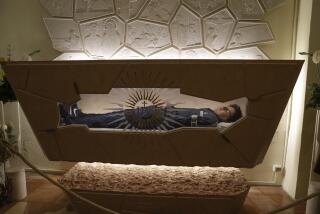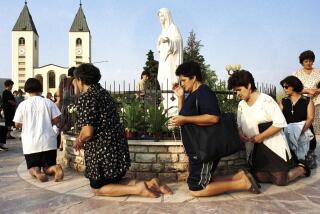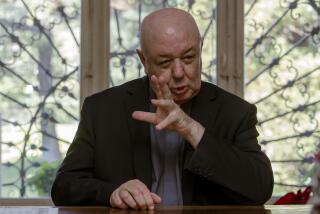Pursuit of Sainthood Can Try the Patience : Catholicism: Since John Paul II has been Pope, the Roman Catholic Church has elevated 260 people to sainthood. But canonization as a saint is a long and complex process and not without controversy.
VATICAN CITY — The road to sainthood is never sure and simple. For some, heaven can wait.
During his papacy, Pope John Paul II has given priority to recognizing saints, raising men and women of heroic virtue to the highest altar for emulation by the faithful.
But the process can be long, controversial, tricky and filled with delicate political issues--especially when the saintly candidate touches a sensitive nerve in public opinion.
Such was true, for example, with the petition on behalf of Queen Isabella I of Spain, which enraged some groups who associate her with the Inquisition and the expulsion of Jews and Muslims from Spain. The Vatican in early April announced that it had delayed action on the proposal but denied that the protests were the cause.
Here are other cases, too, that illustrate the difficult judgments involved in deciding who is worthy of veneration, why and whether the time is ripe:
The Rev. Maximilian Kolbe, a Polish priest, gave his life in 1941 to save another prisoner at the Auschwitz death camp.
Archbishop Oscar Romero, an outspoken critic of government repression in El Salvador, was shot through the heart while saying Mass in 1980.
For his act, Kolbe was declared a martyr and saint of the Roman Catholic Church. Will the same honor go to Romero? Or is his case too politically sensitive?
All will depend on the long and complex process of proclaiming saints, a procedure that can be as revealing for who isn’t chosen for veneration as for who is.
“The purpose is to put before the eyes of people today someone who is an inspiring example,” said the Rev. Paolo Molinari, who as postulator-general of the Jesuits has been pursuing the causes of saints for more than 30 years.
“This brings about the question of the opportuneness of presenting or not presenting some cases. It takes a kind of wisdom and prudence.”
There are no official figures for the total number of saints recognized by the church over the centuries, but the pace of beatifications and canonizations has increased under Pope John Paul II.
So far during his 12-year pontificate, 377 people have been beatified, meaning they are declared “blessed” and can be venerated by the faithful at the local level.
An additional 260 have been canonized, or elevated to sainthood and held up for public prayers by the universal church. Of these, 237 were among groups of martyrs from Vietnam, Korea and the Philippines.
Monsignor Robert Sarno, an American official on the Vatican’s Congregation for the Causes of Saints, estimates that about 1,500 active cases are under consideration.
The Pope is scheduled to beatify seven more people this year, starting with three nuns this spring. The next saint will be canonized in November: the Rev. Joseph Kalinowski, a Polish Carmelite priest who died in 1907.
Because the process for years seemed to favor founders of religious orders with the means and manpower to promote a cause, there is now a stress on finding lay saints.
“More than ever we need candidates,” Sarno said. “We need men and women who, living in various sectors of life, show forth the holiness of the church.”
Understanding the world of saints requires knowledge of some basic rules:
* Beatification and canonization are strictly posthumous honors; the church does not recognize “living saints.”
* Anyone is eligible, from Popes to queens to farmers.
* Candidates must have a reputation of holiness and heroic virtue or died a martyr’s death.
* Beatification requires proof of one posthumous miracle attributed to the candidate’s intercession; a second miracle is needed for canonization. Martyrs automatically qualify for beatification, but need one miracle for sainthood.
* A cause cannot be initiated until at least five years after the candidate’s death. This, Sarno said, is “to allow the hype to die, the dust to settle and the substance to come out.”
Churchmen involved in studying, promoting and deciding the causes of saints say nothing disturbs them more than the common description of their work as “saint-making.”
“The church doesn’t make saints,” Sarno said. “It’s God who makes saints. The church recognizes saints. It recognizes the finger of God at work in the world.”
A cause for sainthood begins under the direction of the local bishop in the diocese where the candidate died. All historical and biographical material, plus any accounts from living witnesses, are gathered and forwarded to Rome.
Here, the Congregation for the Causes of Saints takes over. The congregation has a full-time staff of 26 to study the case, which must clear the scrutiny of a committee of historical, theological and medical experts.
Then the cause goes to a panel of cardinals and bishops, who make their recommendation to the Pope. “This is one of the most democratic, if not the most democratic, processes in the church,” Sarno said.
The Pope may sometimes ask how a certain case is progressing but does not impose his will on the congregation, Sarno said.
John Paul certainly took a special interest in the cause of Kolbe, a fellow Pole and Franciscan priest who was put to death by an injection of carbolic acid at Auschwitz on Aug. 14, 1941.
Kolbe had volunteered to take the place of another prisoner, the father of two sons, when the camp commandant selected 10 men to die following a prison break.
Kolbe was canonized on Oct. 10, 1982, before more than 200,000 faithful in St. Peter’s Square. Invoking his apostolic authority and acting on the request of Polish and German bishops, the Pope declared that Kolbe was a martyr.
Some have suggested that, for all his heroism, Kolbe may not have fit the church’s strict definition of a martyr-- -- someone killed out of hatred of the Catholic faith.
But Sarno says no one was better qualified to judge the case than John Paul, who lived through the Nazi occupation and has a special understanding of Kolbe’s “Polish experience.”
If Kolbe died a martyr’s death, then what about Romero?
The Salvadoran bishop was gunned down at the altar while saying Mass at a small chapel on March 24, 1980. Evidence has pointed to a far-rightist plot, but no one has been arrested or tried for the slaying.
Romero’s cause is complicated by political factors. As a champion of the poor, he made enemies among extreme right-wing groups. His sermons were regarded by some as sympathetic to left-wing rebels.
There is speculation that Romero’s cause has been put on hold for now to prevent his canonization from being used for political purposes. Sarno says the Salvadoran church has not yet formally taken up Romero’s case with the Vatican.
“I think there is a certain reticence on the part of the Vatican to pursue his cause,” said another senior Vatican official, speaking on condition of anonymity. “They feel his message has been misappropriated by some groups and movements as being theirs.”
Another sensitive case for the Vatican was the proposed sainthood for Queen Isabella I of Spain, who commissioned the voyage of Christopher Columbus to the New World in 1492.
Supporters cited her contributions to unifying Spain and spreading Catholicism. They hoped for her beatification in time for 1992, when the church celebrates 500 years of Christianity in the Americas.
But others remembered Isabella as a symbol of intolerance, the queen who expelled Jews and Muslims from Spain. Her beatification “would reopen old wounds that we thought were closed forever,” said Samuel Toledano, head of the Federation of Spanish Jewish Communities.
Vatican officials were extremely reluctant to discuss Isabella’s case. The Vatican press office said only that there is no rush to have her beatified by 1992.
In any case, the weight of public opinion on sainthood for Romero, Isabella and others is not ignored by the Vatican.
“The church’s task has to be the seeking of the truth,” Sarno said. “At the same time it has to be sensitive to the feelings and the needs of people.”
More to Read
Sign up for Essential California
The most important California stories and recommendations in your inbox every morning.
You may occasionally receive promotional content from the Los Angeles Times.










